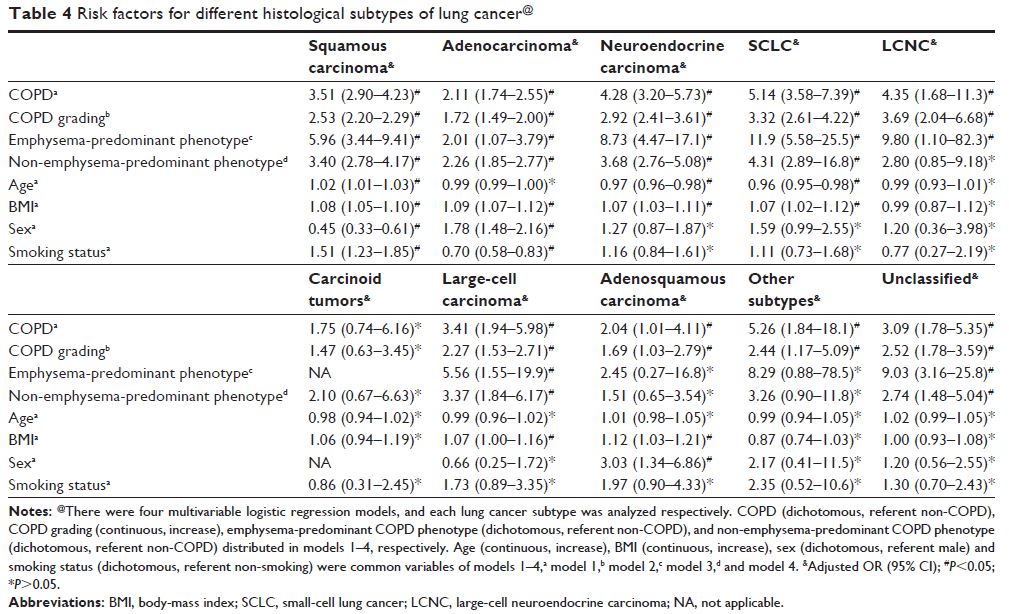9 7 0 5 2
论文已发表
注册即可获取德孚的最新动态
IF 收录期刊
- 3.3 Breast Cancer (Dove Med Press)
- 3.4 Clin Epidemiol
- 2.5 Cancer Manag Res
- 2.9 Infect Drug Resist
- 3.5 Clin Interv Aging
- 4.7 Drug Des Dev Ther
- 2.7 Int J Chronic Obstr
- 6.6 Int J Nanomed
- 2.5 Int J Women's Health
- 2.5 Neuropsych Dis Treat
- 2.7 OncoTargets Ther
- 2.0 Patient Prefer Adher
- 2.3 Ther Clin Risk Manag
- 2.5 J Pain Res
- 2.8 Diabet Metab Synd Ob
- 2.8 Psychol Res Behav Ma
- 3.0 Nat Sci Sleep
- 1.8 Pharmgenomics Pers Med
- 2.7 Risk Manag Healthc Policy
- 4.2 J Inflamm Res
- 2.1 Int J Gen Med
- 4.2 J Hepatocell Carcinoma
- 3.7 J Asthma Allergy
- 1.9 Clin Cosmet Investig Dermatol
- 2.7 J Multidiscip Healthc

慢性阻塞性肺病表型与肺癌组织学亚型之间的联系:一项病例对照研究
Authors Wang W, Xie M, Dou S, Cui L, Zheng CY, Xiao W
Received 4 December 2017
Accepted for publication 27 February 2018
Published 13 April 2018 Volume 2018:13 Pages 1167—1175
DOI https://doi.org/10.2147/COPD.S158818
Checked for plagiarism Yes
Review by Single-blind
Peer reviewers approved by Dr Charles Downs
Peer reviewer comments 2
Editor who approved publication: Dr Chunxue Bai
Background: COPD is considered an independent risk factor for lung cancer.
COPD and lung cancer are both very heterogeneous diseases, and the study herein
investigates the link between COPD phenotypes and specific histological
subtypes of lung cancer.
Methods: This case–control study comprised 2,283 patients with newly diagnosed
pathological lung cancer and 2,323 non-lung cancer controls. All participants
underwent pulmonary function tests. The diagnosis of COPD was based on Global
Initiative for Chronic Obstructive Lung Disease criteria. Subtypes of the two diseases
were categorized according to 2015 World Health Organization classification of
lung cancer and computer quantification of airway collapse on maximum
expiratory flow volume. ORs were estimated using logistic regression analysis.
Results: The prevalence of COPD was higher (32.8%) in lung cancer patients
compared to controls (16.0%). After adjustment for age, sex, body-mass index,
and smoking status, the presence of COPD significantly increased the risk of
lung cancer (OR 2.88, 95% CI 2.48–3.34) and all common histological subtypes
(ORs 2.04–5.26). Both emphysema-predominant and non-emphysema-predominant
phenotypes of COPD significantly increased the risk of lung cancer (OR 4.43,
95% CI 2.85–6.88; OR 2.82, 95% CI 2.40–3.31). Higher risk of squamous-cell
carcinoma and small-cell lung cancer was observed in patients with the
emphysema-predominant than the non-emphysema-predominant phenotype (OR 1.73,
95% CI 1.03–2.89; OR 3.74, 95% CI 1.64–8.53).
Conclusion: COPD was an independent risk factor for lung cancer and all common
histological subtypes. Both emphysema-predominant and non-emphysema-predominant
phenotypes of COPD significantly increased the risk of lung cancer. Relative to
non-emphysema-predominant phenotype of COPD, emphysema-predominant phenotype had
a higher risk of squamous-cell carcinoma and small-cell lung cancer.
Keywords: lung cancer, COPD, risk, phenotype, histology
